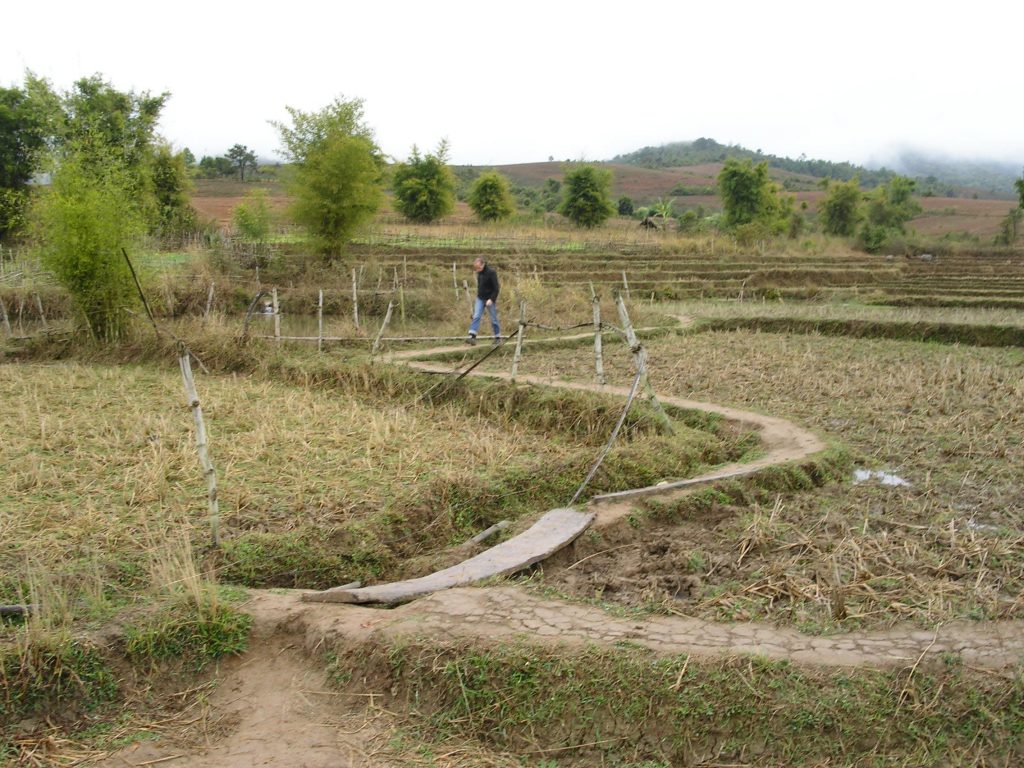I took the bus to Phonsavan towards the east of Laos. The journey itself is about 9 hours long and to begin with I couldn’t work out why as it didn’t look far on the map. It turns out the whole northern part of Laos is mountainous and the road though now sealed winds its way up and down into valleys the whole way. Also a shock was the bus was half empty as we set out and there were only 5 farang on board.
The journey was an experience : 1st I noticed we had an armed guard carrying an AK47, 2nd I realised that Asians do not travel well and the little plastic bags hanging from the ceiling were not for an Easter egg hunt, 3rd at a village half way we picked up a very extended family carrying of all thing a rooster in a bird flu epidemic and 4th it was probably best it was misty so I couldn’t see the drop at the side of the road as we hurtled round hairpins trying to preserve speed for the next climb.
The next day I visited several sites on the Plain of Jars, named after the 2000 year old jars carved from solid stone that litter the area. Some of them area huge (3m tall) and its a mystery how they were moved and what they were used for. Current theories believe they were used as part of a 2 stage burial process with the jars being the store for the 1st few years. 3 main sites are open to visitors but there are at least 16 different clusters of jars. The process of mapping all them is currently under way. A few hundred meters short of the first site the road was cut by work to put a large pipe across underneath it. At first the driver asked us to walk before deciding to drive it. I had my doubts by we got across OK, however on the way back another tour group had got stuck blocking our way. There was nothing else to do but pitch in and haul them out.

Its also one of the areas most heavily bombed by the Americans in their secret war in Indo-china. More bombs were dropped on Laos by the USA in the “Vietnam War” than were used by all sides in WWII. It means the area is full of UXO (unexploded ordinance) except where cleared. In particular the US had heavily used cluster bombs, each deploying 600 or so bomblets over a wide area. The big problem being that these bomblets failed to go off in 20% to 30% of cases. It will be another 25 years before Laos’ high priority areas are cleared of UXO and over a century for the country as a whole. Evidence of craters is everywhere and these were mainly caused by little 500lb bombs!!
The hotel I was staying at, the Maly, was owned by the guy who had rediscovered the jars after the war and it was he and his son who had cleared much of the main sites from UXO (unexploded ordinance). It gave the hotel an incredible collection of armaments, with all the candle holders being defused cluster bomblets.
Also staying at the Maly was an guy working for an NGO doing a report on Lao’s UXO and the programmes to solve it (from whom I’ve got some of the above information). He’d flown in, to which I commented that he was a brave man; a Chinese copy of an old Russian design of plane, maintained by local mechanics does not make Lao Aviation’s Yaks the most reliable flying machines in the world. By all accounts it once had a helicopter fleet but they were all lost through attrition (mainly crashing!!) He pointed out that on the bus routes I was to take there was a far greater risk of me being shot than there was of crashing in a dogly Yak, with 2 attacks in 2003 killing over 10 people. The armed guard on thebus took on a whole new light.

We also visited a Lao and a Hmong village so we could compare the two, saw Lao Lao (rice whisky) being made, stopped at an abandoned Russian tank, walked along the dykes of paddy fields to reach one jar site and saw a small field of opium poppies. The only problem the weather was cold, wet and miserable that day and looked like staying the same. I was tempted to go and see the Ho Chi Ming trail and a large field of poppies the next day but decided to head south to Vang Vieng instead. I would see the trail further south.



